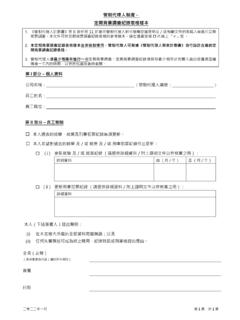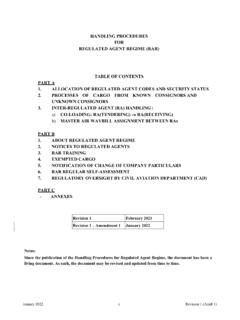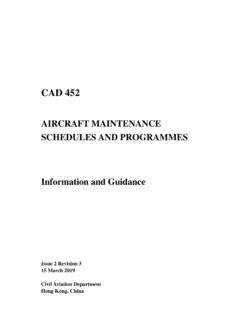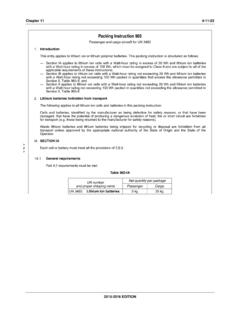Transcription of Packing Instruction 965 - Civil Aviation Department
1 Chapter 11 4-11-25 2017-2018 EDITION Packing Instruction 965 Cargo aircraft onlyfor UN 3480 1. Introduction This entry applies to lithium ion or lithium polymer batteries. This Packing Instruction is structured as follows: Section IA applies to lithium ion cells with a Watt-hour rating in excess of 20 Wh and lithium ion batteries with a Watt-hour rating in excess of 100 Wh, which must be assigned to Class 9 and are subject to all of the applicable requirements of these Instructions; Section IB applies to lithium ion cells with a Watt-hour rating not exceeding 20 Wh and lithium ion batteries with a Watt-hour rating not exceeding 100 Wh packed in quantities that exceed the allowance permitted in Section II, Table 965-II; and Section II applies to lithium ion cells with a Watt-hour rating not exceeding 20 Wh and lithium ion batteries with a Watt-hour rating not exceeding 100 Wh packed in quantities not exceeding the allowance permitted in Section II, Table 965-II.
2 A single cell battery as defined in Part III, sub-section of the UN Manual of Tests and Criteria is considered a cell and must be transported according to the requirements for cells for the purpose of this Packing Instruction . 2. lithium batteries forbidden from transport The following applies to all lithium ion cells and batteries in this Packing Instruction : Cells and batteries, identified by the manufacturer as being defective for safety reasons, or that have been damaged, that have the potential of producing a dangerous evolution of heat, fire or short circuit are forbidden for transport ( those being returned to the manufacturer for safety reasons). Waste lithium batteries and lithium batteries being shipped for recycling or disposal are forbidden from air transport unless approved by the appropriate national authority of the State of Origin and the State of the Operator.
3 IA. SECTION IA Each cell or battery must meet all the provisions of 2; General requirements Part 4;1 requirements must be met. lithium ion cells and batteries must be offered for transport at a state of charge not exceeding 30 per cent of their rated capacity. Cells and/or batteries at a state of charge greater than 30 per cent of their rated capacity may only be shipped with the approval of the State of Origin and the State of the Operator under the written conditions established by those authorities. Note. Guidance and methodology for determining the rated capacity can be found in sub-section of the UN Manual of Tests and Criteria. Table 965-IAUN number and proper shipping nameNet quantity per packagePassengerCargoUN 3480 lithium ion batteriesForbidden35 kg + 4-11-26 Part 4 2017-2018 EDITION Packing Instruction 965 Additional requirements lithium ion cells and batteries must be protected against short circuits.
4 lithium ion cells and batteries must be placed in inner packagings that completely enclose the cell or battery then placed in an outer packaging. The completed package for the cells or batteries must meet the Packing Group II performance requirements. lithium ion batteries with a mass of 12 kg or greater and having a strong, impact-resistant outer casing, or assemblies of such batteries, may be transported when packed in strong outer packagings or protective enclosures ( in fully enclosed or wooden slatted crates) not subject to the requirements of Part 6 of these Instructions, if approved by the appropriate authority of the State of Origin. A copy of the document of approval must accompany the consignment. Batteries manufactured after 31 December 2011 must be marked with the Watt-hour rating on the outside case.
5 Outer packagings Boxes DrumsJerricans Aluminium (4B) Aluminium (1B2)Aluminium (3B2) Fibreboard (4G) Fibre (1G)Plastics (3H2) Natural wood (4C1, 4C2) Other metal (1N2)Steel (3A2) Other metal (4N) Plastics (1H2)Plastics (4H1, 4H2) Plywood (1D)Plywood (4D) Steel (1A2)Reconstituted wood (4F) Steel (4A) IB. SECTION IB Quantities of lithium ion cells or batteries that exceed the allowance permitted in Section II, Table 965-II are subject to all of the applicable provisions of these Instructions (including the requirements in paragraph 2 of this Packing Instruction and of this section) except for the provisions of Part 6. lithium ion cells or batteries shipped in accordance with the provisions of Section IB must be described on a dangerous goods transport document as set in Part 5;4.
6 The Packing Instruction number 965 required by 5; a) must be supplemented with IB . All other applicable provisions of Part 5;4 apply. lithium ion cells and batteries may be offered for transport provided that each cell and battery meets the provisions of 2; a) and e) and the following: 1) for lithium ion cells, the Watt-hour rating (see the Glossary of Terms in Attachment 2) is not more than 20 Wh; 2) for lithium ion batteries, the Watt-hour rating is not more than 100 Wh; the Watt-hour rating must be marked on the outside of the battery case except for those batteries manufactured before 1 January 2009; General requirements Cells and batteries must be packed in strong outer packagings that conform to Part 4; , and (except ). lithium ion cells and batteries must be offered for transport at a state of charge not exceeding 30 per cent of their rated capacity.
7 Cells and/or batteries at a state of charge greater than 30 per cent of their rated capacity may only be shipped with the approval of the State of Origin and the State of the Operator under the written conditions established by those authorities. Note. Guidance and methodology for determining the rated capacity can be found in sub-section of the UN Manual of Tests and Criteria. Table 965-IB ContentsNet quantity per package PassengerCargoLithium ion cells and batteriesForbidden10 kg Chapter 11 4-11-27 2017-2018 EDITION Packing Instruction 965 Additional requirements Cells and batteries must be packed in inner packagings that completely enclose the cell or battery then placed in a strong rigid outer packaging. Cells and batteries must be protected so as to prevent short circuits.
8 This includes protection against contact with conductive materials within the same packaging that could lead to a short circuit. Each package must be capable of withstanding a m drop test in any orientation without: damage to cells or batteries contained therein; shifting of the contents so as to allow battery to battery (or cell to cell) contact; release of contents. Each package must be marked with the appropriate lithium battery mark (Figure 5-3) in addition to the appropriate Class 9 hazard label (Figure 5-26) and the cargo aircraft only label (Figure 5-28). + Note. The provisions for a lithium battery handling label as contained in the 2015-2016 Edition of these Instructions (Part 5; and Figure 5-32 of the 2015-2016 Edition) may continue to be used in lieu of the lithium battery mark until 31 December 2018.
9 > Outer packagings Boxes DrumsJerricans Aluminium AluminiumAluminium Fibreboard FibrePlasticsNatural wood Other metalSteelOther metal PlasticsPlastics PlywoodPlywood SteelReconstituted wood Steel > II. SECTION II lithium ion cells and batteries, when complying with Section II of this Packing Instruction , are only subject to the following additional provisions of these Instructions: Part 1; (General Transport of dangerous goods by post); Part 5; g) and j) (Shipper s responsibilities General requirements); + Part 7; (Operator s responsibilities Loading restrictions on the flight deck and for passenger aircraft); + Part 7; (Operator s responsibilities Loading of cargo aircraft); Part 7; (Operator s responsibilities Reporting of dangerous goods accidents and incidents); Part 8; (Provisions concerning passengers and crew Dangerous goods carried by passengers or crew).
10 And Paragraphs 1 and 2 of this Packing Instruction . lithium ion cells and batteries may be offered for transport provided that each cell and battery meets the provisions of 2; a) and e) and the following: 1) for lithium ion cells, the Watt-hour rating (see the Glossary of Terms in Attachment 2) is not more than 20 Wh; 2) for lithium ion batteries, the Watt-hour rating is not more than 100 Wh; the Watt-hour rating must be marked on the outside of the battery case except for those batteries manufactured before 1 January 2009. 4-11-28 Part 4 2017-2018 EDITION Packing Instruction 965 General requirements Cells and batteries must be packed in strong outer packagings that conform to Part 4; , and (except ).











